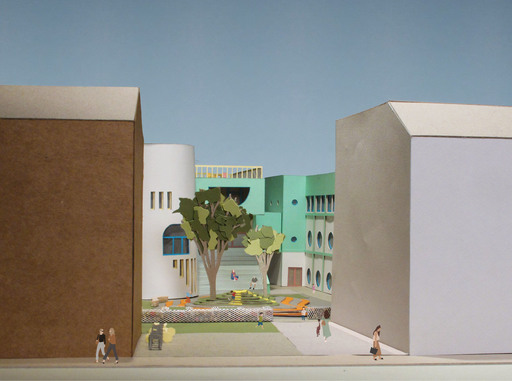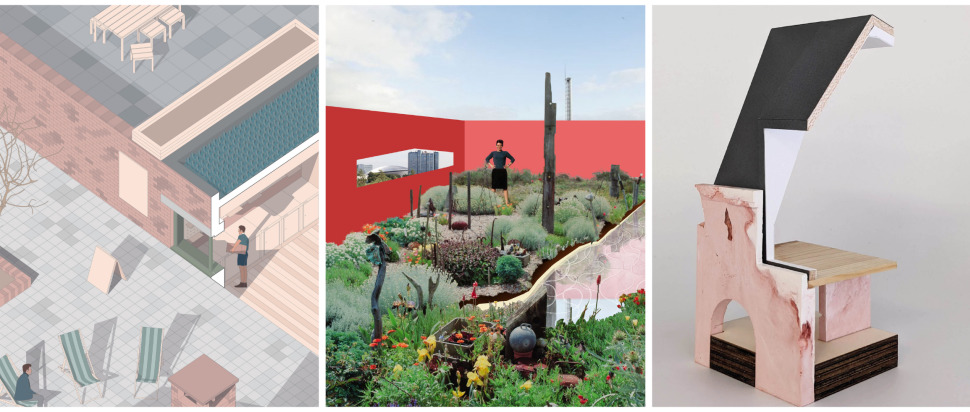GSA 2022: Mackintosh School of Architecture
Re-use, adaptability and community-focused place-making emerge as themes among students at the Glasgow School of Art Mackintosh School of Architecture
2021-22 saw a full return to studio working for students at the Mackintosh School of Architecture, and with that the panoramic views and open plan spaces of the Bourdon – the dry-docked brutalist spaceship of a building, situated on the west flank of the GSA campus. All stages of graduating students this year have Glasgow, in all its shades, as the perennially inspiring testing ground for their work. The common thread is an awareness of the biggest design challenge of our time – the twin climate and biodiversity crises and the future of the city.
Stage 3 students look beyond the strict boundaries of ‘site’ to rethink the sometimes myopic process of urban development, grabbing with both hands what survives of our city’s industrial infrastructure and re-programming it as both the scaffold and conduit for an ultra-low energy, urban food revolution. This loosely takes shape in the Urban Food Exchange or Urfex – a polymorphic building typology defined more by its function than any one form.
Hamid Habibi takes a deep-dive into the canalside communities around his north Glasgow site to produce an integrated and comprehensive development. By resolving a challenging slope into useful circulation, he prioritises accessibility through placemaking. The result is a terrace of gently winding pathways doubling as a stepped seating area, made from masonry reclaimed directly from local demolition. This anchors the project within the landscape, is sensitive to our climate future, and ties the programme together on multiple axes.
Ryan Woods evokes the collective memory of place, by interposing his site’s industrial vernacular and cultural identity with the material and practices of industrial agriculture. The result is a scheme which provides a place to exchange knowledge, expertise, skills and experiences, framed by the activities and environments of food cultivation, production and distribution. His conception of the Urban Food Exchange is ultimately expressed in the material choices and construction of the project; assembled from a modular kit intended to facilitate adaptive growth and ensure longevity.
Emelie Fraser sees her project as a means to connect the disparate and diverse communities on the fringes of her site, at a centrally located herb garden within her scheme. Shared experience through the common language of the senses are the basis for the exchange of cultural knowledge through food. The provision of a well-equipped kitchen, and communal indoor and outdoor gathering spaces, provide the setting for further interaction and extend the possibilities for all-weather usefulness.
Arin Chance Beaver bridges the gap between the urban realm and nature at his site at the Maryhill Locks, drawing agriculture right into the heart of Glasgow’s urban fabric. Two low-rise buildings are placed in direct conversation with a 20-storey tower block, expressing a shared DNA with Alvar Aalto’s experimental Muuratsalo House and Sigurd Lewerentz’s Blomsterkiosk. Natural and reusable materials, in standardised material dimensions, make the building easy to break down and re-use at the end of its life.
Projects from Stage 4 close in on the streets and buildings in the oxter of London Road and Gallowgate in Calton, known to most as The Barras, for their investigations on themes of domesticity and labour. Adam Cowan’s Barras Materials Bank is an armature for the practical application of the circular economy – a synthesis of the Barras market itself. Surplus or waste materials generated in the ongoing demolition/re-construction of the area are collected and re-distributed for projects within the community. By offering sustainability as a practical pursuit, the project entrenches community resilience by increasing opportunities for meaningful participation with lasting outcomes.
With the return to the studio, model-making as a design and presentation tool is strongly represented. Shona Beattie tests the form, mass, and material character of her Materials Skills Centre proposal via assemblages of clear and opaque casting, acrylic and timber. They work equally well as standalone pieces and as an experiential journey through her project. Andreea Stanuta’s physical models (pictured below) are tangible articulations of her architectural language. Her proposal for Barras Play Centre recognises the need for accessible family-friendly places in the neighbourhood, which ranks among the most deprived in the city according to the Scottish Index of Multiple Deprivation.

Marc Stewart looks to the artist Agnes Denes’ 1982 provocation on world hunger – a guerrilla-planted wheatfield on a high-value, vacant, Manhattan plot – as the inspiration for Sustainable Living Centre for Calton, addressing the neighbourhood’s striking dichotomy of deprivation and development. Referencing local repositories such as The Scottish Storytelling Centre and Glasgow Women’s Library, Rachel Crooks’ Barras Storytelling Archive scrapes back centuries of well-trodden Calton routes to reveal and re-establish cultural knowledge obscured by time. This process extends her vision through the layers of culture laid down in Glasgow’s historical phases of growth, particularly The Highland Clearances, to redress what she identifies as a Scottish culture of forgetfulness.
The final year students of Stage 5 build their own theses around the theme The Ethical City. The quality of work represented in the cohort is breathtaking, and impossible to summarise here, but a slice in any direction reveals a wealth of visual material recasting Glasgow in myriad ways.
Chester Chesney presents an alternate reality to the tenement city by flipping the relationship of street and back court, reclaiming the common back buildings and bringing them into the experience of the street. His vision to ‘reclaim the common’ is informed by his own experience of life in Govanhill, and his work is a powerfully graphical exploration of that densest of neighbourhoods.
Philip Elverson cites Cedric Price’s Fun Palace – a seminal though never realised thought experiment in polyvalent space – in his possible repurposing of the cathedralesque undercroft of the Kingston Bridge. He reimagines the vaulting space as a framework for gradual occupation, using resource-friendly, modular interventions, directly benefiting local communities displaced by the construction of the motorway. The project shares DNA with the Hielanman’s Umbrella – once also a temporary gathering place for persons displaced. Elverson acknowledges that our current vehicular infrastructure can become a palimpsest for the post-car planning of a not-too-distant future, by reusing what is, largely, already there.
Carl Jonsson envisions what the safeguarding of an environmental legacy means in an age of climate disruption and biodiversity death. The site he selects is the Govan Graving Docks, a Taggart-scape of post-industrial decline. His proposal yields to the natural re-integration into the wild, already underway in the surrounding ecology. His project is framed within the post-COP26 narrative that argues that protecting the natural world is not only a matter of collective legacy, but also fundamental to human nature. The different parts of the programme – a seed bank, interior garden and exterior garden – overlay the docks at varying scales and impact, reflecting a desire to respect not only the site’s current state, but its transformative history and uncertain future.
For anyone interested in the city of Glasgow, model-making, drawing, illustration, or simply the creative process itself, experiencing the work of these students first-hand in a gallery setting is unmissable.
The Mackintosh School of Architecture Degree Show runs 11-19 Jun at Fleming House, 134 Renfrew Street, and the Grace and Clark Fyfe Gallery, Bourdon Building, Glasgow
It is also available to view online at gsashowcase.net
